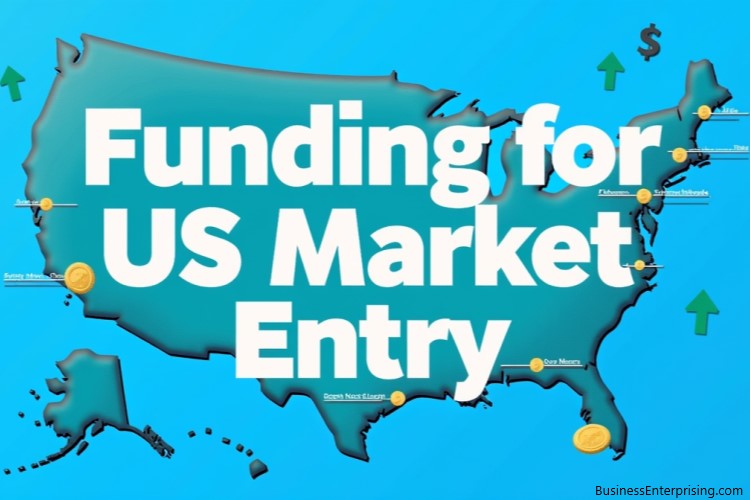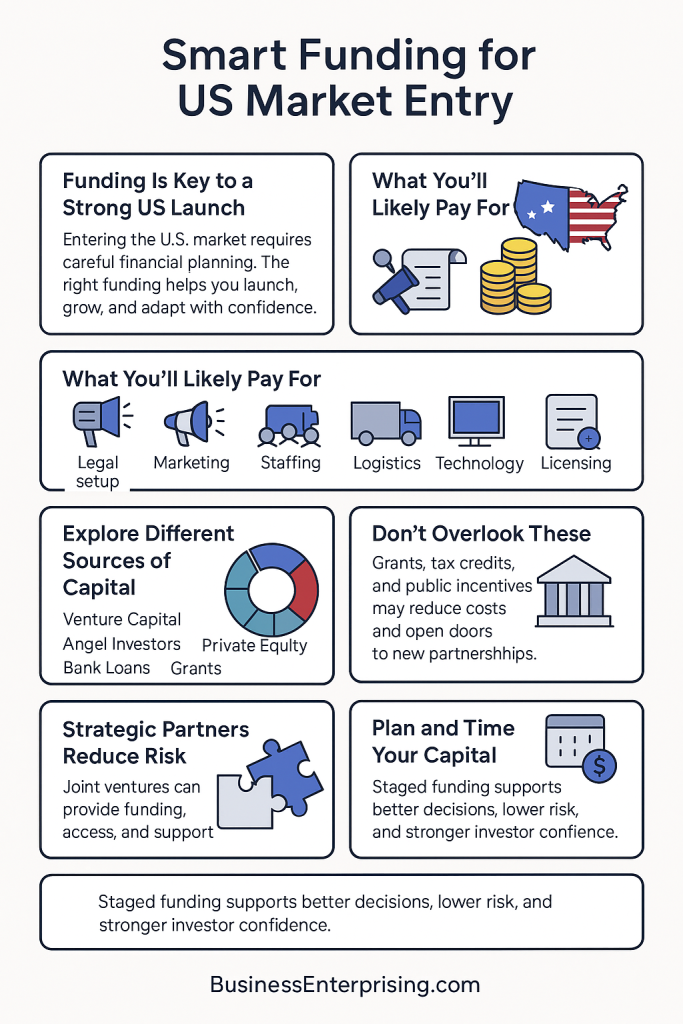 Entering the U.S. market requires more than ambition—it requires capital. That’s why funding for US market entry must be part of your plan. Without proper funding, even great products or services can struggle to gain traction. You’ll need money for research, setup, staffing, and marketing.
Entering the U.S. market requires more than ambition—it requires capital. That’s why funding for US market entry must be part of your plan. Without proper funding, even great products or services can struggle to gain traction. You’ll need money for research, setup, staffing, and marketing.
However, it’s not just about how much you raise. It’s about where it comes from and how you use it. Each funding source comes with expectations and limitations. Therefore, you need a clear strategy that supports your specific business model and growth goals.
Additionally, entering a foreign market brings new risks. You may face unfamiliar rules, customer behavior, and operational needs. That’s why your funding approach should match your stage of entry. Planning this in phases helps you stay flexible and reduce waste.
You also have more options than you might think. From investors to grants, several channels can support your entry. However, choosing the right mix takes careful thought. You’ll want to balance speed, control, and long-term impact.
If you’re preparing to expand, now is the time to review your funding strategy. A well-planned approach gives you more room to grow and respond to challenges. Additionally, it sends a strong message to partners and investors.
With the right capital in place, you can move forward with more clarity. Funding should support progress, not delay it. Your job is to line it up with your next move—and get ready to scale.
Understanding the Costs of Entering the U.S. Market
Expanding into the U.S. market involves more than launching a product. You’ll need to prepare for several upfront and recurring expenses. Without a clear budget, it’s easy to underestimate the true cost of entry. That can slow your progress or increase your financial risk.
Legal costs are one of the first things to consider. You may need help with business formation, contracts, trademarks, and regulations. Therefore, it’s smart to include legal fees in your early planning. These costs vary by state and industry.
Additionally, you’ll need to account for marketing. You may invest in branding, website development, and digital campaigns. Building awareness in a new market takes time and consistent effort. Therefore, your marketing budget should reflect both short-term and long-term goals.
Staffing is another key cost. Even a small U.S. team adds expenses for salaries, benefits, and payroll processing. If you plan to hire locally, budget for recruiting and onboarding. If you relocate existing staff, that brings separate relocation costs.
Logistics also play a major role. You might need warehousing, shipping, or supply chain partners. These services require upfront contracts and ongoing coordination. Therefore, it’s important to plan for inventory storage and delivery.
Additionally, compliance costs can surprise new entrants. From licenses to taxes, U.S. rules require ongoing attention. You’ll need help staying up to date and avoiding penalties. That might involve consulting fees or industry-specific audits.
When planning funding for US market entry, it helps to fully understand these costs. With a detailed budget, you’ll reduce financial surprises and improve your decision-making.
Types of Funding Available for International Companies
Finding the right funding source can shape how you enter the U.S. market. You’ll want to explore every option available to you. Each type of funding comes with different expectations, timelines, and benefits. Choosing the right one depends on your goals and structure.
Venture capital is a strong fit for high-growth startups. However, these investors expect fast scaling and a clear exit plan. If you’re seeking larger sums and rapid growth, this route may align well with your goals.
Additionally, private equity can provide funding for more established companies. These firms often look for operational control or long-term growth potential. This option fits businesses with revenue and plans to expand further.
Angel investors offer a flexible approach. They usually invest smaller amounts and bring valuable experience. Therefore, early-stage companies benefit from both capital and mentorship. These relationships often open doors to new networks and opportunities.
Traditional bank loans are another choice. While banks have strict requirements, they offer structured repayment plans. If you have financial history and a strong business case, this may work well.
Government programs also provide options. Some federal, state, or local initiatives offer loans or grants for foreign companies. These programs vary by location and industry. However, they often require detailed applications and business plans.
Additionally, alternative lenders may fill gaps. These non-bank sources offer faster approvals and flexible terms. You may pay higher rates, but they help bridge funding gaps when traditional options don’t apply.
Understanding the types of funding for US market entry gives you more control. With the right mix, you’ll be better prepared to move forward.
Building a Business Case for Investors
Investors want to see a clear plan before they commit funds. You’ll need more than an idea—you’ll need real data. A strong business case shows you’ve thought through your U.S. entry and understand the market ahead.
Start with a defined market opportunity. However, avoid making general claims. Use actual market size, buyer behavior, and competition to support your position. This gives your plan more credibility and shows you’ve done the work.
Additionally, describe how your product fits the market. Outline what makes your offer different and why it will succeed. Focus on specific customer segments, pricing strategy, and projected demand. Keep it focused on what investors care about most—results.
Your financial projections should also be realistic. Therefore, show expected revenue, operating costs, and break-even timelines. Avoid inflated numbers. Instead, build your case around achievable growth supported by data and experience.
Additionally, outline your entry strategy. Explain how you will launch, scale, and manage operations. Investors want to see that you understand U.S. logistics, hiring, compliance, and marketing. Each step should link back to financial goals and operational planning.
Include how you plan to use the funds. Investors want to know how their money supports progress. Break down the budget into categories like staffing, inventory, or marketing.
When preparing funding for US market entry, this kind of business case helps you stand out. It shows you’re not guessing—you’re building with purpose. That confidence helps attract partners who want to support a plan that’s ready to move.
Grants and Incentive Programs for Foreign Businesses
Expanding into the U.S. doesn’t always mean relying on private capital. In many cases, public support is available to reduce your costs. Federal, state, and local governments offer grants, tax credits, and other business incentives. These programs often support foreign companies entering the U.S. market.
However, each program has its own rules. You’ll need to meet eligibility requirements and follow application timelines. Therefore, researching early helps you avoid missing opportunities.
Federal grants typically focus on innovation, technology, or job creation. These programs are competitive but can provide non-dilutive capital. That means you receive funding without giving up equity. Additionally, federal agencies sometimes partner with regional offices to support foreign investment.
States also offer strong support. Many have economic development agencies focused on attracting foreign businesses. Therefore, you may find funding tied to job creation, property development, or manufacturing. These incentives can reduce startup and operational costs significantly.
Additionally, local governments may offer cash grants, property tax breaks, or infrastructure assistance. These benefits often target specific zones or cities seeking investment. If you’re flexible on location, you may access more support by choosing the right area.
You’ll still need to show a solid plan. Granting agencies want to back companies that will invest in the local economy. A clear strategy and job forecast can improve your chances.
When planning funding for US market entry, it helps to explore public programs alongside private options. That extra support can give you financial breathing room and a stronger launch.
Leveraging Strategic Partnerships and Joint Ventures
Entering a new market takes more than capital. You also need connections, insights, and operational support. Strategic partnerships can help fill those gaps. By working with a U.S. company, you gain access to resources that would take time and money to build alone.
Additionally, a local partner can help reduce risk. You won’t have to navigate the market entirely on your own. Many U.S. firms seek partners that offer something new—products, technology, or customer reach. Therefore, the right partnership can create mutual value.
Joint ventures also offer a shared path forward. Both companies invest in a new entity, combining funding, staff, and assets. This structure can speed up entry while spreading costs and responsibilities. It’s especially helpful when local operations or licenses are required.
However, you still need clear terms. Define roles, goals, and exit options early. A good agreement keeps everyone aligned and avoids future disputes. Additionally, strong communication helps build trust over time.
Some partners may also provide working capital or other funding. Therefore, they can directly support your early-stage expenses. That extra support can be the difference between delaying or moving forward.
Additionally, established partners often bring systems and supply chains. You may save time by using their platforms, logistics, or vendor networks. That lets you focus on growth instead of setup.
When planning funding for US market entry, partnerships deserve serious consideration. You get more than money—you get experience, reach, and operational support. Those advantages can smooth your entry and speed up results.
Timing and Staging Your Capital Needs
Planning your market entry is more than raising capital. You also need to decide when and how to use that funding. Without a clear plan, you may run short before your business gains traction. That’s why it helps to align your funding with each growth phase.
Start with research and validation. This phase includes customer interviews, legal checks, and early product testing. Therefore, you need only a modest budget to gather insights and test assumptions. However, skipping this step often leads to larger losses later.
Next comes your initial entry. This phase may involve forming a U.S. entity, hiring staff, or launching a pilot. At this stage, your capital needs grow. Additionally, you’ll want to prepare for early marketing and compliance costs. Investors often want to see early traction before offering more support.
Scaling is the final stage. Here, your focus shifts to expanding sales, staff, and infrastructure. This phase demands the most funding. Therefore, your earlier performance should support a larger raise. You may use this capital for inventory, partnerships, or systems that help manage growth.
Additionally, break down your funding goals by activity. Be clear about how much you need and when. This helps you track progress and keep investors aligned.
When planning funding for US market entry, staged capital keeps your business moving without waste. It helps you raise what you need, when you need it. That control gives you the flexibility to adjust and grow at a pace that fits your market response.
Conclusion
Entering the U.S. market brings big opportunities, but it also requires careful planning and funding. You’ll face new costs, rules, and competition. That’s why having the right strategy makes a real difference. With preparation, you can move forward with less risk and more control.
However, funding isn’t just about raising money. You also need to choose the right sources and use funds at the right time. Structuring your capital around clear goals helps you stay focused and avoid waste. Additionally, it gives your investors more confidence in your plan.
Every business has different needs. Therefore, the right approach to funding depends on your size, industry, and timeline. What works for one company may not work for another. You don’t need to follow a set path—you need a plan that fits your goals.
Additionally, exploring grants, partnerships, and staged funding opens more options. These tools reduce your upfront burden and help you scale with flexibility. It’s not just about getting in the door—it’s about staying in and growing over time.
Funding for US market entry is about more than cash flow. It’s about building a foundation that supports your expansion. When you align your plan, team, and funding, your launch becomes more manageable—and more likely to succeed.
Your next steps don’t have to be complicated. Focus on what you need now, and build from there. With the right plan and support, entering the U.S. market becomes a strategic move, not a risky leap.


